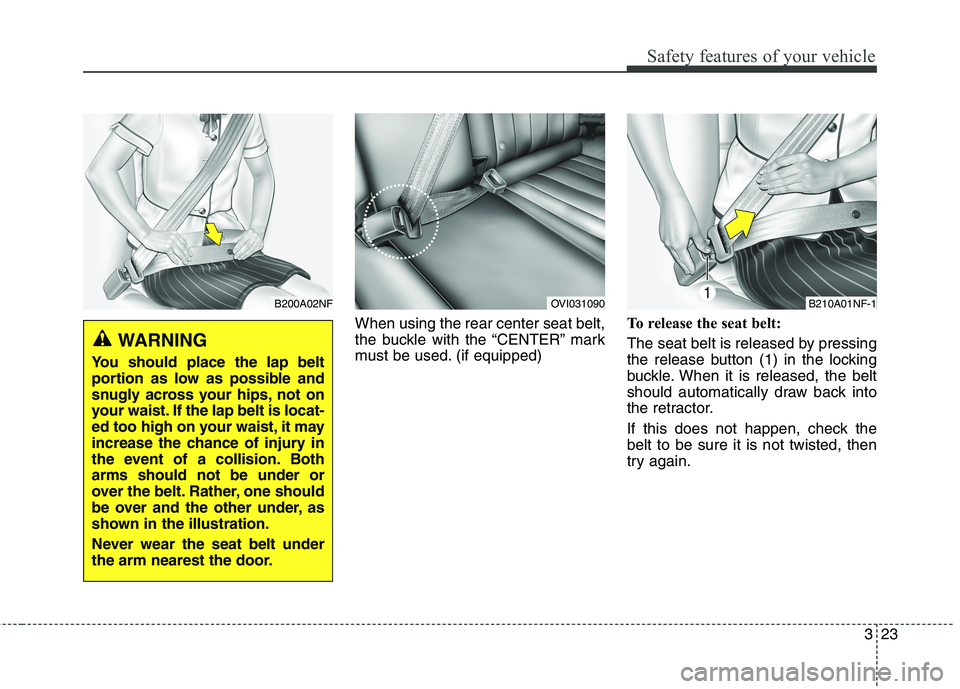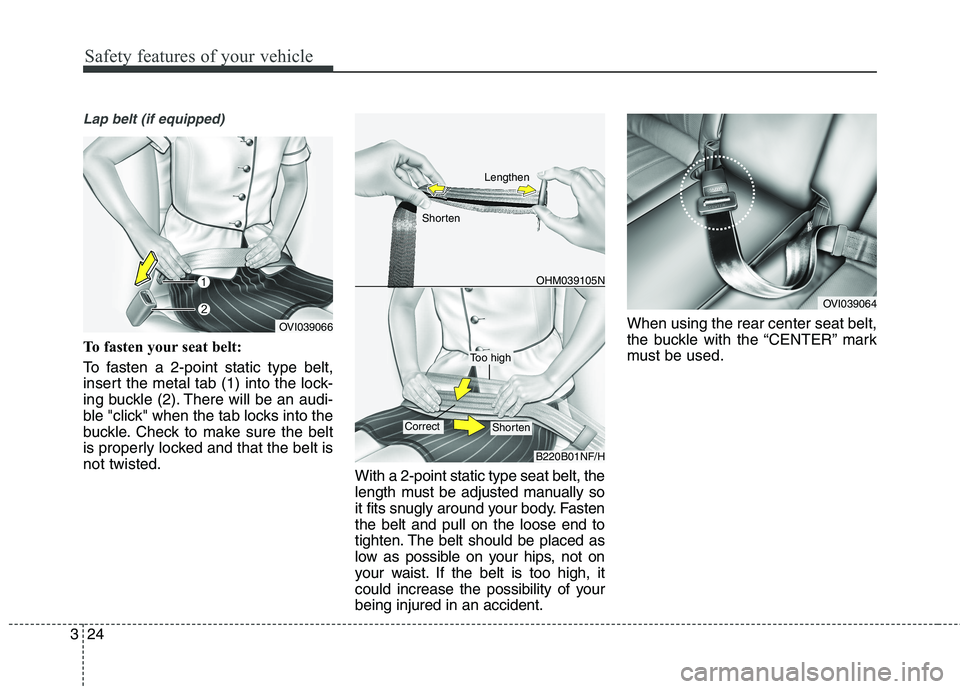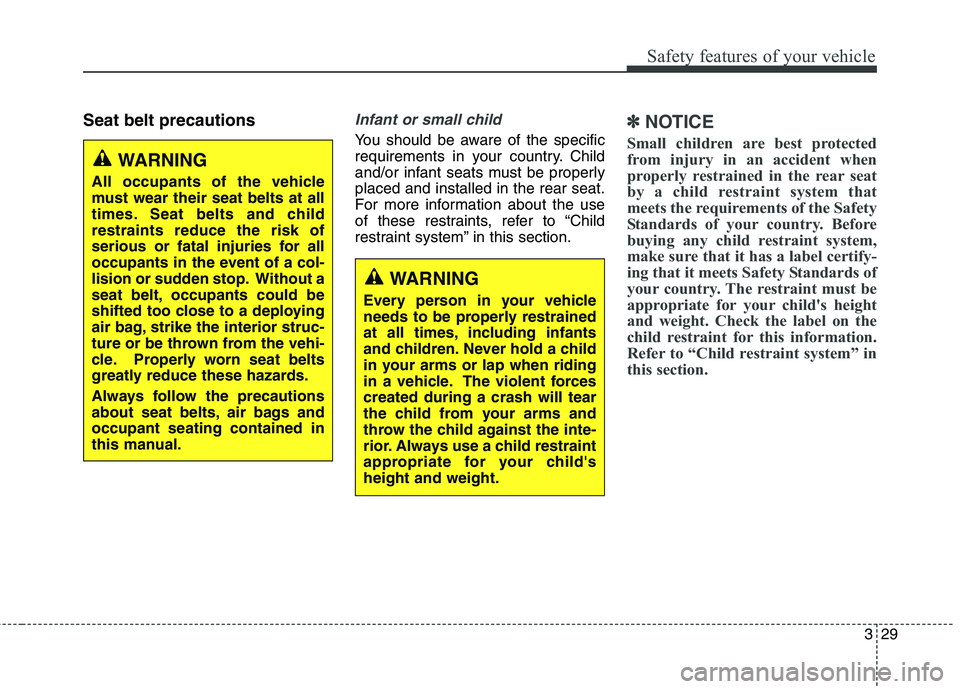2013 KIA QUORIS belt
[x] Cancel search: beltPage 38 of 485

323
Safety features of your vehicle
When using the rear center seat belt,
the buckle with the “CENTER” mark
must be used. (if equipped)To release the seat belt:
The seat belt is released by pressing
the release button (1) in the locking
buckle. When it is released, the belt
should automatically draw back into
the retractor.
If this does not happen, check the belt to be sure it is not twisted, then
try again.
B200A02NF
WARNING
You should place the lap belt
portion as low as possible and
snugly across your hips, not on
your waist. If the lap belt is locat-
ed too high on your waist, it may
increase the chance of injury in
the event of a collision. Botharms should not be under or
over the belt. Rather, one should
be over and the other under, as
shown in the illustration.
Never wear the seat belt under
the arm nearest the door.
B210A01NF-1OVI031090
Page 39 of 485

Safety features of your vehicle
24
3
Lap belt (if equipped)
To fasten your seat belt:
To fasten a 2-point static type belt,
insert the metal tab (1) into the lock-
ing buckle (2). There will be an audi-
ble "click" when the tab locks into the
buckle. Check to make sure the belt
is properly locked and that the belt isnot twisted.
With a 2-point static type seat belt, the
length must be adjusted manually so
it fits snugly around your body. Fastenthe belt and pull on the loose end to
tighten. The belt should be placed as
low as possible on your hips, not on
your waist. If the belt is too high, it
could increase the possibility of yourbeing injured in an accident.When using the rear center seat belt,
the buckle with the “CENTER” mark
must be used.
OVI039066
OVI039064
OHM039105N
B220B01NF/H
Too high
ShortenCorrect
Lengthen
Shorten
Page 40 of 485

325
Safety features of your vehicle
To release the seat belt:
When you want to release the seat
belt, press the button (1) in the lock-
ing buckle.Pre-tensioner seat belt
Your vehicle is equipped with driver's and front passenger's pre-tensioner
seat belts. The pre-tensioner seat
belts can be activated, where thefrontal collision is se
vere enough,
together with the air bags.
When the vehicle stops suddenly, or
if the occupant tries to lean forward
too quickly, the seat belt retractor will
lock into position. In certain frontal
collisions, the pre-tensioner will acti-
vate and pull the seat belt into tighter
contact against the occupant's body. Retractor Pretensioner
The purpose of the retractor pre-tensioner is to make sure that theshoulder belts fit in tightly againstthe occupant's upper body in cer-
tain frontal collisions.
If the system senses excessive ten-
sion on the driver or passenger'sseat belt when the pre-tensioner sys-
tem activates, the load limiter inside
the retractor pre-tensioner willrelease some of the pressure on the
affected seat belt.
B210A02NF-1
WARNING
The center lap belt latching
mechanism is different from
those for the rear seat shoulder
belts. When fastening the rearseat shoulder belts or the cen-
ter lap belt, make sure they are
inserted into the correct buck-
les to obtain maximum protec-
tion from the seat belt system
and assure proper operation.
OED030300
WARNING
For your safety, be sure that the belt webbing is not loose or
twisted and always sit properly
on your seat.
Page 41 of 485

Safety features of your vehicle
26
3
The seat belt pre-tensioner system
consists mainly of the following com-
ponents. Their locations are shown in
the illustration:
1. SRS air bag warning light
2. Retractor pre-tensioner assembly
3. SRS control module
✽✽
NOTICE
Both the driver's and front pas- senger's pre-tensioner seat belts
may be activated in certain frontal
collisions.
When the pre-tensioner seat belts are activated, a loud noise may be
heard and fine dust, which may
appear to be smoke, may be visible
in the passenger compartment.
These are normal operating condi-
tions and are not hazardous.
Although it is harmless, the fine dust may cause skin irritation and
should not be breathed for pro-
longed periods. Wash all exposed
skin areas thoroughly after an
accident in which the pre-tensioner
seat belts were activated.
Because the sensor that activates the SRS air bag is connected with
the pre-tensioner seat belt, the
SRS air bag warning light on
the instrument panel will illumi-
nate for approximately 6 seconds
after the ignition switch has been
turned to the ON position, and
then it should turn off.WARNING
To obtain maximum benefit
from a pre-tensioner seat belt:
1. The seat belt must be worn correctly and adjusted to the
proper position. Please read
and follow all of the important
information and precautions
about your vehicle’s occu-
pant safety features – includ-
ing seat belts and air bags –
that are provided in this man-ual.
2. Be sure you and your passen- gers always wear seat belts
properly.
ODMESA2024
Page 42 of 485

327
Safety features of your vehicle
CAUTION
If the SRS air bag warning lightdoes not illuminate when theignition switch is turned to ON, or if it remains illuminated afterilluminating for approximately 6seconds, or if it illuminates while the vehicle is being driv-en, we recommend that the sys-tem be inspected by an author- ized Kia dealer.
WARNING
Pre-tensioners seat belt sys- tem are designed to operate
only one time. After activa-
tion, pre-tensioner seat belts
must be replaced. All seat
belts, of any type, should
always be replaced after they
have been worn during a colli-sion.
The pre-tensioner seat belt assembly mechanisms
become hot during activation.
Do not touch the pre-tension-
er seat belt assemblies for
several minutes after they
have been activated.
Do not attempt to inspect or replace the pre-tensioner seat
belts yourself. We recommendthat the system be inspected
by an authorized Kia dealer.
Do not strike the pre-tension- er seat belt assemblies.
Do not attempt to service or repair the pre-tensioner seat
belt system in any manner.
(Continued)(Continued)
Improper handling of the pre-tensioner seat belt assem-
blies, and failure to heed the
warnings not to strike, modify,
inspect, replace, service orrepair the pre-tensioner seat
belt assemblies may lead to
improper operation or inad-
vertent activation and serious
injury.
Always wear the seat belts when driving or riding in a
motor vehicle.
If the vehicle or pre-tensioner seat belt must be discarded,
we recommend that you con-
tact an authorized Kia dealer.
Page 43 of 485

Safety features of your vehicle
28
3
Pre-Safe Seat belt (PSB) (if equipped)
The purpose of the pre-safe seat belt
is to prevent passengers from getting
hurt by tightening the seat belt right
before a collision or dangerous
maneuver. The pre-safe seat belt warning light
will illuminate if there is a problem
with your pre-safe seat belt.
Have the system checked if:
The light does not turn on briefly
when you turn the engine
start/stop button to the ON posi-tion.
The light stays on after illumination for approximately 3 seconds.
The light comes on while the vehi- cle is in motion. In order to maximize the safety of the
passenger, the pre-safe seat belt
system operates as below
The seat belt is tightened when:
- The vehicle senses a collision
- Emergency braking situationoccurs
- Losing control of the vehicle
The seat belt vibrates when: - The vehicle senses a object toonear the vehicle
Other functions is winding a loose
seat belt after unfastening the seatbelt.
OVI039069
OKH052117L
CAUTION
The pre-safe seat belt activates only when the passenger iswearing his/her seat belt.
CAUTION
Do not be surprised when the seat belt vibrates. It's not a mal-function but a warning for yoursafety.
■ Type A■Type B
Page 44 of 485

329
Safety features of your vehicle
Seat belt precautionsInfant or small child
You should be aware of the specific
requirements in your country. Child
and/or infant seats must be properlyplaced and installed in the rear seat.
For more information about the use
of these restraints, refer to “Child
restraint system” in this section.
✽✽NOTICE
Small children are best protected
from injury in an accident when
properly restrained in the rear seat
by a child restraint system that
meets the requirements of the Safety
Standards of your country. Before
buying any child restraint system,
make sure that it has a label certify-
ing that it meets Safety Standards of
your country. The restraint must be
appropriate for your child's height
and weight. Check the label on the
child restraint for this information.
Refer to “Child restraint system” in
this section.
WARNING
All occupants of the vehicle
must wear their seat belts at all
times. Seat belts and childrestraints reduce the risk of
serious or fatal injuries for all
occupants in the event of a col-
lision or sudden stop. Without a
seat belt, occupants could be
shifted too close to a deploying
air bag, strike the interior struc-
ture or be thrown from the vehi-
cle. Properly worn seat belts
greatly reduce these hazards.
Always follow the precautions
about seat belts, air bags andoccupant seating contained in
this manual.
WARNING
Every person in your vehicle
needs to be properly restrained
at all times, including infants
and children. Never hold a child
in your arms or lap when riding
in a vehicle. The violent forcescreated during a crash will tear
the child from your arms and
throw the child against the inte-
rior. Always use a child restraint
appropriate for your child'sheight and weight.
Page 45 of 485

Safety features of your vehicle
30
3
Larger children
Children who are too large for child
restraint systems should always
occupy the rear seat and use the
available lap/shoulder belts. The lap
portion should be fastened and
snugged on the hips and as low as
possible. Check periodically if belt
fits. A child's squirming could put the
belt out of position. Children are
given the most safety in the event of
an accident when they are restrained
by a proper restraint system in the
rear seat. If a larger child (over age
12) must be seated in the front seat,the child should be securely
restrained by the available lap/shoul-der belt and the seat should be
placed in the rearmost position.Children age 12 and under should be
restrained securely in the rear seat.NEVER place a child age 12 and
under in the front seat. NEVER place
a rear facing child seat in the front
seat of a vehicle. If the shoulder belt portion slightly
touches the child’s neck or face, tryplacing the child closer to the center
of the vehicle. If the shoulder belt still
touches their face or neck they need
to be returned to a child restraint sys-tem.
Restraint of pregnant women
Pregnant women should wear
lap/shoulder belt assemblies when-
ever possible according to specific
recommendations by their doctors.
The lap portion of the belt should be
worn AS SNUGLY AND LOW AS
POSSIBLE on the hips, not a crossthe abdomen.
WARNING
- Shoulder
belts on small children
Never allow a shoulder belt to be in contact with a child’s
neck or face while the vehicleis in motion.
If seat belts are not properly worn and adjusted on chil-
dren, there is a risk of death or
serious injury.
WARNING - Pregnant
women
Pregnant women must never
place the lap portion of the
safety belt over the area of the
abdomen where the fetus is
located or above the abdomenwhere the belt could crush the
fetus during an impact.